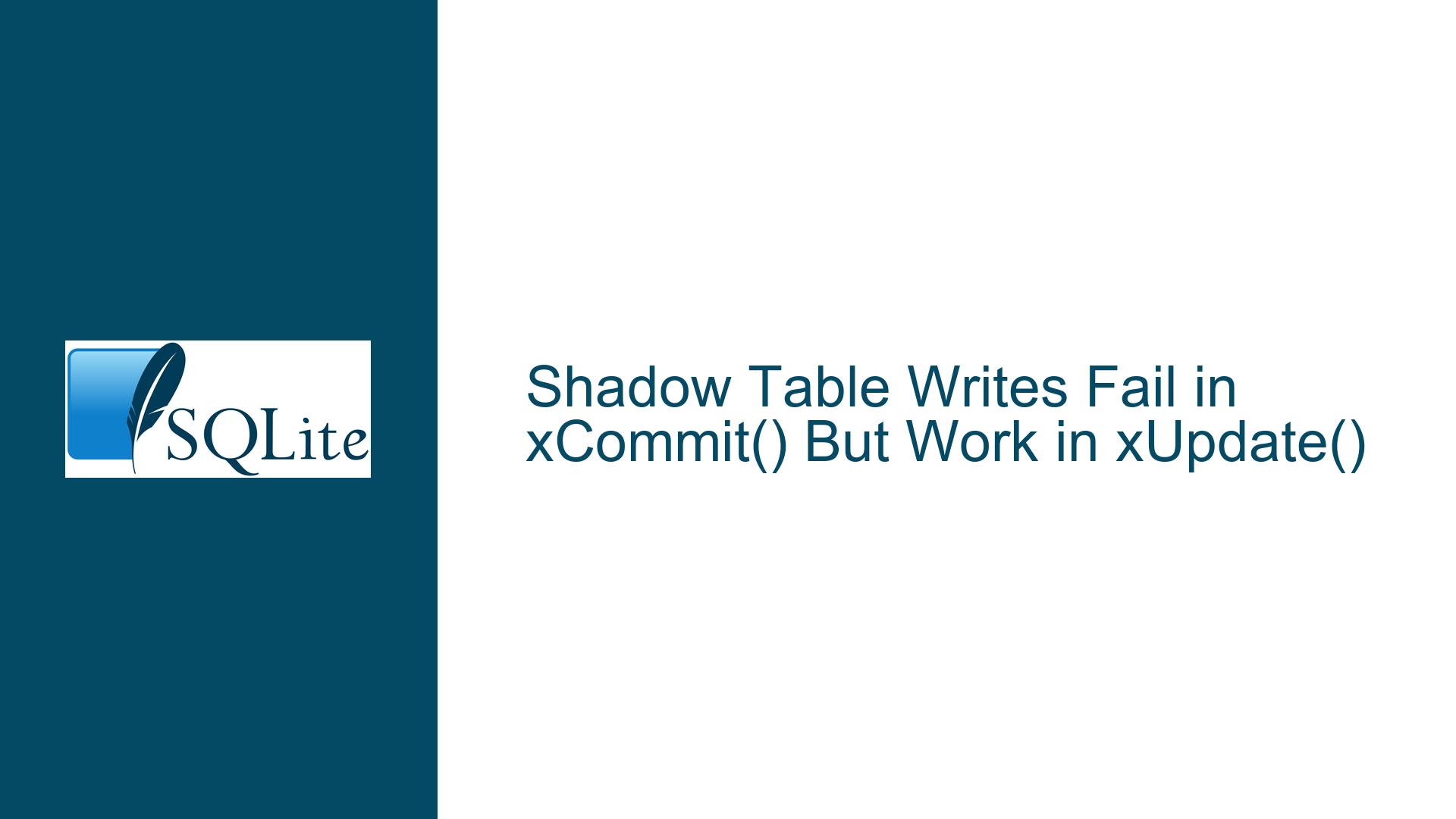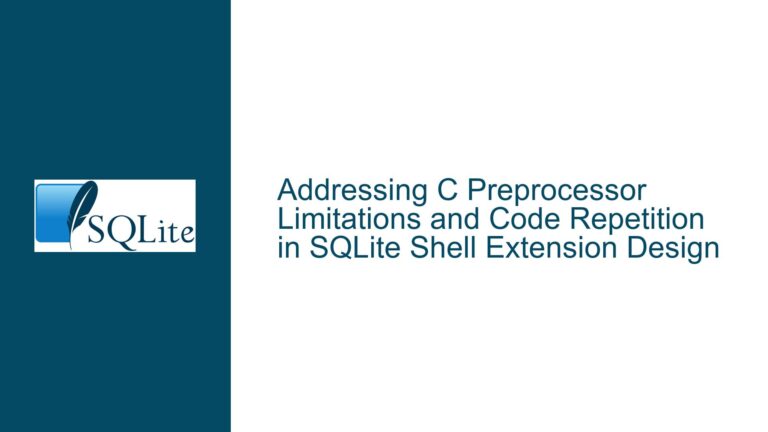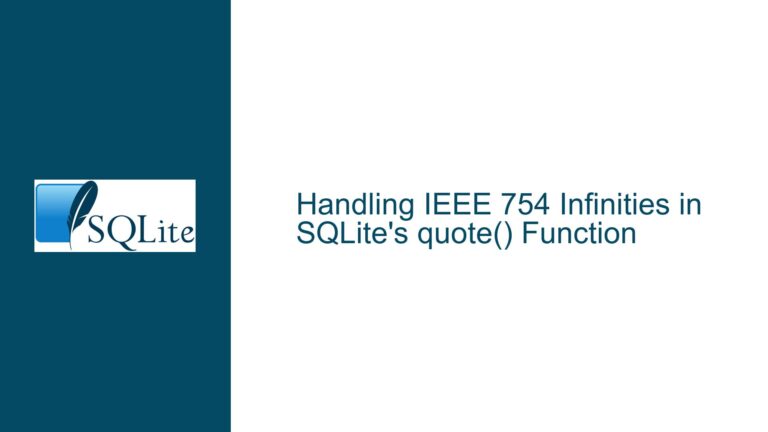Shadow Table Writes Fail in xCommit() But Work in xUpdate()
Shadow Table Transaction Lifecycle and Write Visibility in Virtual Tables
The interaction between virtual table implementations and their corresponding shadow tables involves nuanced transaction management within SQLite. A common point of confusion arises when attempting to modify shadow tables during specific phases of transaction execution, particularly when writes executed in the xCommit() method fail to persist while those in xUpdate() succeed. This discrepancy stems from the sequence of operations in SQLite’s transaction lifecycle and the visibility of database handles during virtual table method execution. Below is a comprehensive breakdown of the underlying mechanisms, potential triggers for data persistence failures, and actionable solutions to ensure reliable shadow table modifications.
Transaction Phases and Shadow Table Write Permissions
Shadow tables are internal SQLite tables used by virtual table implementations to store persistent state. They differ from ordinary tables in that they are not directly accessible to user SQL statements—modifications must originate from the virtual table implementation itself. The SQLite documentation specifies that shadow tables can only be written by SQL invoked from within virtual table methods. However, not all virtual table methods provide equal access to the transaction context required for these writes to become permanent. The critical factor is the transaction state at the moment the write occurs.
The xUpdate() method is invoked during the execution of INSERT, UPDATE, or DELETE statements on the virtual table. At this stage, the transaction is active, and modifications to shadow tables are part of the ongoing transaction. These changes are visible to subsequent operations within the same transaction and are committed to disk during the transaction’s finalization phase. In contrast, the xCommit() method is called after the outermost transaction has been committed. Writing to shadow tables in xCommit() attempts to modify the database outside of a transaction, leading to unpredictable behavior. Depending on the configuration of the database connection (e.g., autocommit mode), such writes may be auto-committed immediately, silently ignored, or—in the worst case—corrupt the shadow table’s integrity.
The distinction between xSync() and xCommit() is pivotal. The xSync() method is part of the transaction finalization sequence, called before the transaction is committed. It is designed for operations that must atomically persist virtual table state alongside the main database transaction. Writing to shadow tables in xSync() ensures they are included in the transaction’s write-ahead log (WAL) or rollback journal, guaranteeing atomicity and durability. Attempting shadow table modifications in xCommit() bypasses these safeguards, as the transaction is already finalized, and the database handle may no longer be in a writable state.
Misaligned Transaction Finalization and Shadow Table Isolation
The root cause of shadow table writes failing in xCommit() lies in the misalignment between the virtual table’s transaction handling and SQLite’s internal transaction management. When a virtual table participates in a transaction, SQLite coordinates its methods (xBegin(), xSync(), xCommit(), xRollback()) with the broader transaction lifecycle. The xCommit() method is intended for cleanup or notification tasks that occur after the transaction has been irreversibly committed. Any database modifications initiated at this stage operate in a new, implicit transaction (if autocommit is enabled) or remain pending until the next explicit transaction. This disrupts the atomicity expected of virtual table operations, as shadow table changes are decoupled from the original transaction that triggered them.
For example, consider a virtual table that logs changes to an audit trail stored in a shadow table. If the audit entries are written in xCommit(), they may fail to reflect the actual committed data if the xCommit() method is called after the transaction has already finalized. This creates a race condition: the main transaction’s changes are visible to other database connections, but the shadow table’s audit entries might be missing or incomplete. Worse, if the virtual table implementation assumes that shadow table writes in xCommit() are part of the original transaction, it might omit error checking, leading to silent data loss.
Another contributing factor is the isolation level of the database connection. Shadow table writes in xCommit() may not be visible to subsequent transactions if they are executed in a separate autocommit transaction. This violates the atomicity guarantees expected by virtual table consumers, who assume that all modifications (virtual table and shadow table) are committed as a single unit. In contrast, writes in xSync() are synchronized with the main transaction, ensuring they share the same isolation and durability properties.
Migrating Shadow Table Writes to xSync() and Validating Transaction State
To resolve shadow table write failures in xCommit(), developers must restructure their virtual table implementations to perform such writes in xSync(). The following steps outline the process:
Audit Virtual Table Methods for Shadow Table Access: Identify all instances where shadow tables are modified. Trace the call stack to determine which virtual table methods (e.g.,
xUpdate(),xSync(),xCommit()) are responsible for these modifications. Writes occurring inxCommit()are prime candidates for relocation.Refactor xSync() to Handle Shadow Table Writes: Move the logic responsible for inserting, updating, or deleting shadow table records from
xCommit()toxSync(). Ensure thatxSync()constructs and executes the necessary SQL statements to modify the shadow tables. For example:static int vtSync(sqlite3_vtab *pVTab){ MyVirtualTable *p = (MyVirtualTable*)pVTab; sqlite3 *db = p->db; // Execute shadow table INSERT as part of the transaction sqlite3_exec(db, "INSERT INTO shadow_table VALUES (1, 'data');", 0, 0, 0); return SQLITE_OK; }This ensures shadow table modifications are included in the transaction’s atomic commit.
Validate Transaction State During xSync(): Use
sqlite3_get_autocommit()to confirm that the database connection is inside an active transaction duringxSync(). If autocommit is enabled (indicating no active transaction), abort the shadow table write and return an error:static int vtSync(sqlite3_vtab *pVTab){ MyVirtualTable *p = (MyVirtualTable*)pVTab; sqlite3 *db = p->db; if( sqlite3_get_autocommit(db) ){ return SQLITE_ERROR; // No active transaction } // Proceed with shadow table writes }This guards against invalid transaction states that could lead to data corruption.
Test with Nested Transactions and Savepoints: Virtual tables may participate in nested transactions or savepoints. Ensure that
xSync()correctly handles partial transactions by testing scenarios where the virtual table is used withinSAVEPOINTandRELEASEcommands. Shadow table writes should only be persisted when the outermost transaction is committed.Enable Debug Logging for Shadow Table Operations: Temporarily enable SQLite’s debug logging (
sqlite3_config(SQLITE_CONFIG_LOG, ...)) to trace the execution of shadow table SQL statements. Verify that inserts intended for the shadow table are executed duringxSync(), notxCommit(). Cross-reference log timestamps with transaction boundaries to confirm alignment.
By adhering to these steps, developers can ensure that shadow table modifications are atomic, consistent, and durable, aligning with the transactional guarantees provided by SQLite’s virtual table framework.






